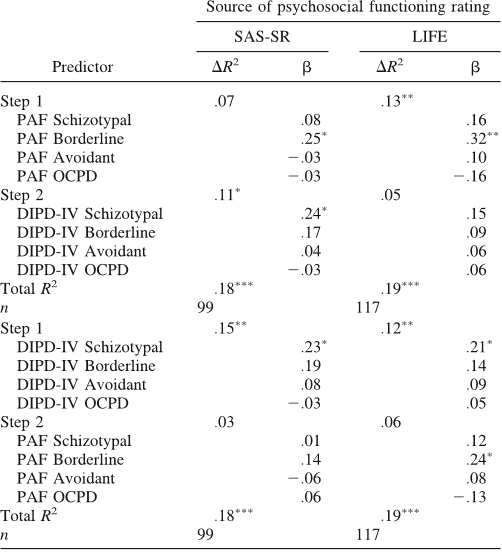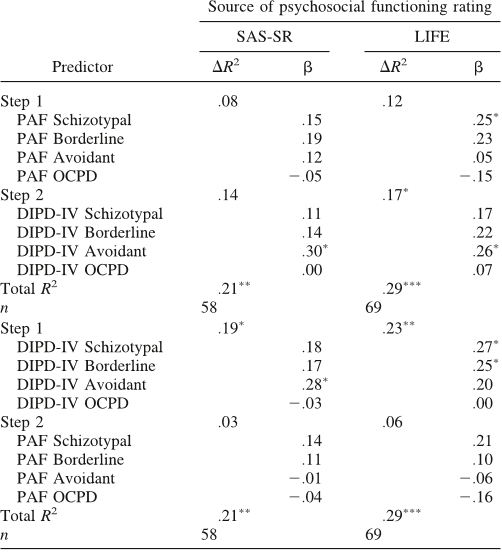The complexity of diagnosing personality disorders (PDs) has
been a long-standing issue in psychiatry (Westen, 1997; Zimmer-
man, 1994). Several methods exist for diagnosing PDs, including
semistructured diagnostic interviews, self-report questionnaires,
clinician-rated Q-sort instruments, as well as unstructured diagno-
ses made by treating clinicians (McDermut & Zimmerman, 2005).
Although research has relied primarily on semistructured diagnos-
tic interviews and self-report questionnaires, therapists typically
base PD diagnoses on their unstructured interviews and clinical
contacts with patients (Perry, 1992; Westen, 1997; Zimmerman,
2011). Despite debate regarding the relative merits of different
diagnostic methods (Westen & Muderrisoglu, 2003; Zimmerman
& Mattia, 1999), no study has yet compared the predictive validity
of clinicians’ naturalistic PD diagnoses with those from self-report
questionnaires or semistructured interviews (Zimmerman, 2011).
Existing research has repeatedly indicated that clinician-
generated PD diagnoses do not agree well with those from self-
report measures (Davidson, Obonsawin, Seils, & Patience, 2003;
Hyler, Rieder, Williams, & Spitzer, 1989; Morey, Blashfield,
Webb, & Jewell, 1988; Rossi, Van den Brande, Tobac, Sloore, &
Hauben, 2003) or semistructured interviews (Dreessen & Arntz,
1999; Fridell & Hesse, 2006; Samuel & Widiger, 2010). This poor
agreement is not unique to PDs, and has been noted for various
psychiatric diagnoses (Rettew, Lynch, Achenbach, Dumenci, &
Ivanova, 2009). More importantly, fundamental questions regard-
ing the incremental predictive validity of diagnoses assigned by
clinicians relative to different methods have not been answered.
Research has compared the validity of self- and informant reports
of PD (Klein, 2003; Oltmanns & Turkheimer, 2009), but there is
a critical need for analogous work comparing clinical diagnoses
with other methods. Such work is crucial for determining whether
and how different sources of information might be usefully com-
bined. Currently, the optimal approach for how researchers and
clinicians should most validly identify PDs remains unclear.
Although research on clinical judgment offers reasons for skep-
ticism about the validity of clinician ratings in general (Grove,
Zald, Lebow, Snitz, & Nelson, 2000; Meehl, 1954), there are
compelling reasons to believe that their PD diagnoses might be
useful and valid. Therapists’ diagnostic impressions rely on exten-
sive training and take into consideration information about the
client’s life gleaned across extended periods of clinical interac-
tions. Pilkonis, Heape, Ruddy, and Serrao (1991) noted “clinical
judgment, of course, has its own limitations, but it would seem
unwise to develop assessment tools that are unrelated to thoughtful
clinical experience” (p. 46). In addition, Westen (1997) suggested
that clinicians take a holistic approach to diagnosis, situating them
well to describe complex personality pathology. Others contend
that clinicians’ PD ratings are superior to self-report because
patients’ ability to accurately assess their own personality might be
limited by mood states, lack of insight, or presentation biases
(Ganellen, 2007; Huprich, Bornstein, & Schmitt, 2011). Finally,
Morey et al. (1988) suggested that semistructured diagnostic in-
terviews also might have limitations because “a relatively brief
interview situation does not seem particularly well suited to the
task of assessing long-term personological characteristics” (p. 47).
Despite these concerns, there are reasons to believe that patient-
reported information from semistructured interviews and/or self-
report questionnaires can usefully contribute to PD diagnoses
(Zimmerman & Mattia, 1999). Thus, although clinicians might not
routinely ask direct questions about PD symptoms or use semi-
structured interviews and self-report questionnaires, they incorpo-
rate such information to inform their diagnoses if it is available.
Importantly, because semistructured interviews explicitly assess
the longitudinal presence of PD symptoms, they might have
greater ability to disentangle episodic state artifacts from more
durable trait-based PD syndromes (Loranger et al., 1991; Morey et
al., 2010).
As treating therapists almost always play the primary role in
diagnosing PDs in clinical settings, understanding the relative
validity of their impressions carries particular importance. Com-
paring clinicians’ diagnoses with those from self-report question-
naires or semistructured diagnostic interviews would be useful for
prospectively predicting clinically relevant outcomes that extend
beyond specific diagnostic features, such as psychosocial function-
ing. We conducted such a comparison using data from the Col-
laborative Longitudinal Personality Disorders Study (CLPS;
Gunderson et al., 2000). The CLPS is well suited for this investi-
gation as the baseline assessment included diagnoses from treating
clinicians collected using a modified version of the Personality
Assessment Form (PAF; Shea, Glass, Pilkonis, Watkins, & Do-
cherty, 1987; Shea et al., 1990). This allowed them to record the
degree to which patients evinced the prototypical characteristics of
each of four study PDs (viz., schizotypal, borderline, avoidant,
obsessive-compulsive).
The PAF provides a relevant, externally valid method for con-
ducting such an analysis as it closely approximates the way clini-
cians make PD diagnoses in clinical practice. The PAF’s format is
also timely, as it uses a prototype-matching approach that mirrors
the original proposal for diagnosing PDs in the Diagnostic and
Statistical Manual of Mental Disorders, fifth edition (DSM–5). In
fact, the PAF and research that had used it were cited as primary
support for the Work Group’s proposal (Skodol, Bender, et al.,
2011; Skodol, Clark, et al., 2011). This proposal subsequently was
criticized by a number of PD scholars (Pilkonis, Hallquist, Morse,
& Stepp, 2011; Widiger, 2011; Zimmerman, 2011) and aban-
doned. Nonetheless, other prominent researchers and clinicians
have strongly argued that the prototype-matching approach should
become the standard method of PD diagnosis (Shedler et al.,
2010).
The benefit and goal of using the PAF for collecting clinicians’
impressions is to maximize external validity (i.e., most closely
match the type of PD diagnoses typically made in clinical prac-
tice), not to provide equivalence with other methods (Westen &
Weinberger, 2004). Westen and colleagues have demonstrated that
when clinicians administer a systematic clinical interview (i.e., the
Clinical Diagnostic Interview, CDI; Westen, 2004) and record
their impressions using the Shedler-Westen Assessment Procedure
(SWAP; Westen & Shedler, 1999), their PD diagnoses become
more reliable across independent raters (Westen & Muderrisoglu,
2006; Westen, Shedler, Bradley, & DeFife, 2012). Although in-
formative, such a diagnostic strategy (i.e., a 2-hr administration of
the CDI followed by the sorting of 200 SWAP items) is not
standard practice in naturalistic settings. Perhaps recognizing this,
Westen and his colleagues have also been the primary proponents
of the prototype-matching approach (Shedler & Westen, 2004;
Westen, DeFife, Bradley, & Hilsenroth, 2010; Westen, Shedler, &
Bradley, 2006) that helped inform the original DSM–5 proposal
(Skodol, Bender, et al., 2011; Skodol, Clark, et al., 2011). The
This document is copyrighted by the American Psychological Association or one of its allied publishers.
This article is intended solely for the personal use of the individual user and is not to be disseminated broadly.
651
VALIDITY OF CLINICIANS’ PERSONALITY DISORDER DIAGNOSES












